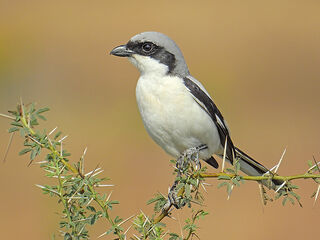Environment
Voles Trim Grass to Thwart Flying Predators
By damaging bunchgrass, voles make their habitat safer from predatory birds.
Posted March 14, 2022 Reviewed by Jessica Schrader
Key points
- In the presence of predatory birds, voles alter their habitat by trimming tall, unpalatable bunchgrass.
- Decreases in bunchgrass result in better visibility for the voles and fewer places for the birds to perch.
- By acting as ecosystem engineers, voles reduce predation risk and increase their survival.

When it comes to the battle between tiny rodents known as Brandt’s voles and carnivorous birds called shrikes, the birds may seem to have all the advantages. Shrikes, or butcherbirds, are formidable predators, known for the macabre habit of impaling their prey on branches and thorns. They are capable of killing small animals like mice and lizards with a paralysis-inducing beak pinch to the spinal cord followed by vigorous shaking to break the prey’s neck.
But new research shows the voles can fight back—by making their habitat a safe space.

Predator Versus Prey
On the plains of Inner Mongolia, China, shrikes use a plant called bunchgrass as both a perch when scanning for voles to eat and as a place to store their catches. Using field surveys and experimental manipulations, an international team of researchers recently found that voles modify their habitat by cutting tall bunchgrass when shrikes are nearby.
The voles don’t eat or use the bunchgrass. They chew on the bottom parts of the stems and leaves and dig burrows that cut the roots. This damages the bunchgrasses, making them less suitable as perches and larders for the shrikes and clearing the habitat so voles are better able to see shrikes coming.
“The decrease in bunchgrass led to fewer visits from shrikes and thus, lower vole mortality rates,” says Dirk Sanders of the University of Exeter, one of the study’s authors.
What’s more, when Sanders and his colleagues put nets up over certain areas to exclude shrikes, the voles stopped trimming the bunchgrass, illustrating the adaptive nature of the behavior.
Rodent Renovators
Sanders and his colleagues say this behavior puts Brandt’s voles in the category of ecosystem engineers, animals that change their environment. It’s not uncommon—think of beavers, earthworms, and termites, to name a few.
The effects that ecosystem engineers exert on habitats and other species are well studied. For instance, elephants open up large areas of the African savanna, making it harder for predators to ambush prey. But these studies have focused on how habitat modifications by one species make areas safer for other species, rather than their own.

“This is a novel study in showing that the species doing the habitat engineering is decreasing its own predation risk,” says Sanders.
“These voles actually change their behavior when they perceive the risk of predators and alter their habitat to reduce the predation risk.”
Sanders and his colleagues say that while this study is unique, the behavior it documents may not be. Nearly every herbivore species faces predation risks and many likely have the ability to alter their habitats to some degree. The interplay between predation risk and ecosystem engineering may be an important but underappreciated aspect at play in other natural communities.
References
Zhong Z, Li G, Sanders D, Wang D, Holt RD, and Zhang Z. A rodent herbivore reduces its predation risk through ecosystem engineering. Current Biology March 11, 2022. Doi: 10.1016/j.cub.2022.02.074.


